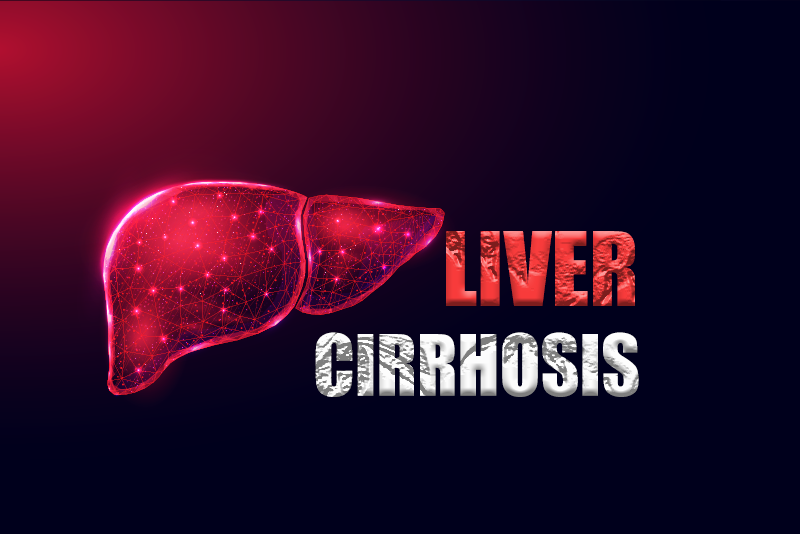A progressive condition that develops over many years, liver cirrhosis results in scarring (fibrosis) of the liver that is caused by long-term liver damage. The scarring of the liver tissues can affect blood flow through the liver, causing liver dysfunction. Also called end-stage liver disease, the condition is caused by long-term exposure to toxins such as alcohol or viral infections. This condition more commonly affects men than women. As cirrhosis progresses, more and more scar tissue forms, making it difficult for the liver to function by itself. Damages that occur to the liver cannot be controlled. If diagnosed at an early stage, damages to the liver tissue can be effectively controlled or reversed. Treatment for liver cirrhosis involves a combination of medications, incorporation of positive lifestyle habits and surgical procedures such as liver transplantation (in severe cases). Proper documentation is necessary to justify medical necessity and selection of codes for billing. A reliable medical billing and coding company can help in accurate and timely claim submission for appropriate reimbursement.
Liver Cirrhosis – Causes and Symptoms
Long-term viral hepatitis infection and chronic alcohol abuse are the most common causes of cirrhosis in the United States. Cirrhosis caused by alcohol is usually the result of regular alcohol intake (more than these amounts) over 10 or 12 years. Other related causes such as autoimmune diseases, fat accumulating in the liver (nonalcoholic fatty liver disease), iron buildup in the body (hemochromatosis), cystic fibrosis, biliary atresia, consumption of toxins (including medications) and hereditary and genetic conditions can lead to liver damage and cirrhosis.
Typically, there are no symptoms associated with early cirrhosis. However, as scar tissue accumulates, it undermines the liver’s ability to function properly and causes certain symptoms such as reduced appetite, weight loss, swelling in the legs, feet or ankles (edema), jaundice, redness in the palms of the hands, nausea and weakness and fluid accumulation in the abdomen (ascites). If left untreated or not diagnosed at an early stage, the condition can lead to several complications – high blood pressure in the veins, bleeding, infections, buildup of toxins in the brain, enlargement of the spleen and increased risk of liver cancer.
Tied down by complex billing regulations?
Let OSI handle your entire medical billing process. Contact us for reliable outsourcing services!
Diagnosis, Treatment and Medical Codes for Liver Cirrhosis
Diagnosis of the condition involves a detailed medical history review and physical examination. A routine and complete blood count test or checkup may be performed to analyze the symptoms. A combination of other tests – liver function tests, alpha fetoprotein (a liver cancer screening) and imaging tests like ultrasound scan of the liver, MRI and CT scan of the abdomen, Magnetic resonance elastography (MRE) and upper endoscopy may be performed. In severe cases, liver biopsy (a tissue sample for diagnosis) will be done to identify the severity, extent and cause of liver damage. Treatment procedures include – intravenous antibiotics, hemodialysis and banding procedures. In severe cases of cirrhosis, a liver transplant may be the last treatment option.
ICD-10 Codes for Liver Cirrhosis
ICD-10 code K74 denotes Fibrosis and cirrhosis of liver. K74 is a billable/specific ICD-10-CM code that can be used on the medical claim to indicate a diagnosis for reimbursement purposes –
- K74 Fibrosis and cirrhosis of liver
- K74.0 Hepatic fibrosis
- K74.00 Hepatic fibrosis, unspecified
- K74.01 Hepatic fibrosis, early fibrosis
- K74.02 Hepatic fibrosis, advanced fibrosis
- K74.1 Hepatic sclerosis
- K74.2 Hepatic fibrosis with hepatic sclerosis
- K74.3 Primary biliary cirrhosis
- K74.4 Secondary biliary cirrhosis
- K74.5 Biliary cirrhosis, unspecified
- K74.6 Other and unspecified cirrhosis of liver
- K74.60 Unspecified cirrhosis of liver
- K74.69 Other cirrhosis of liver
CPT Codes
- 47133 Donor hepatectomy (including cold preservation), from cadaver donor
- 47135 Liver allotransplantation, orthotopic, partial or whole, from cadaver or living donor, any age
- 47140 Donor hepatectomy (including cold preservation), from living donor; left lateral segment only (segments II and III)
- 47141 Donor hepatectomy (including cold preservation), from living donor; total left lobectomy (segments II, III and IV)
- 47142 Donor hepatectomy (including cold preservation), from living donor; total right lobectomy (segments V, VI, VII and VIII)
- 47143 Backbench standard preparation of cadaver donor whole liver graft prior to allotransplantation, including cholecystectomy, if necessary, and dissection and removal of surrounding soft tissues to prepare the vena cava, portal vein, hepatic artery, and common bile duct for implantation; without trisegment or lobe split
- 47144 Backbench standard preparation of cadaver donor whole liver graft prior to allotransplantation, including cholecystectomy, if necessary, and dissection and removal of surrounding soft tissues to prepare the vena cava, portal vein, hepatic artery, and common bile duct for implantation; with trisegment split of whole liver graft into 2 partial liver grafts (i.e., left lateral segment [segments II and III] and right trisegment [segments I and IV through VIII])
- 47145 Backbench standard preparation of cadaver donor whole liver graft prior to allotransplantation, including cholecystectomy, if necessary, and dissection and removal of surrounding soft tissues to prepare the vena cava, portal vein, hepatic artery, and common bile duct for implantation; with lobe split of whole liver graft into 2 partial liver grafts (i.e., left lobe [segments II, III, and IV] and right lobe [segments I and V through VIII])
- 47146 Backbench reconstruction of cadaver or living donor liver graft prior to allotransplantation; venous anastomosis, each
- 47147 Backbench reconstruction of cadaver or living donor liver graft prior to allotransplantation; arterial anastomosis, each
- 47399 Unlisted procedure, liver
There is no cure for cirrhosis, and it can be life-threatening. The chances of survival for a person with liver cirrhosis depends on several factors, including the causes, the severity of the scarring, patient age and overall health and the treatment modalities adopted.
Medical billing and coding for liver conditions require knowledge regarding the right modifiers and payer-specific medical billing for correct and on-time reimbursement. With all the complexities involved, the support of a professional medical billing company would prove useful to document liver cirrhosis correctly.






